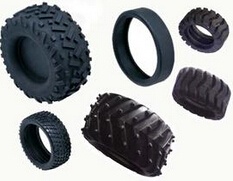Rubber: A highly elastic polymer material with reversible deformation. It is elastic at room temperature, and can produce large deformation under the action of a small external force, and can be restored to its original state after removing external force. Rubber is a completely amorphous polymer with a low glass transition temperature (T g) and a large molecular weight, often greater than several hundred thousand.
The word rubber comes from the Indian cau-uchu, which means "tears of tears." Natural rubber is obtained by solidifying and drying the latex which is discharged when the rubber is cut by the trefoil tree. In 1770, British chemist J. Priestley discovered that rubber could be used to erase pencil writing. At that time, the material used for this purpose was called rubber, and the term has been used ever since. The molecular chain of rubber can be cross-linked, and the rubber after cross-linking is deformed by an external force, and has a rapid recovery ability, and has good physical and mechanical properties and chemical stability. Rubber is the basic raw material for the rubber industry and is widely used in the manufacture of tires, hoses, tapes, cables and other rubber products.

The trefoil tree provides the most commercial rubber. It secretes a large amount of sap containing rubber emulsion when it is damaged (such as the bark of the stem is cut).
In addition, fig trees and some plants of the family Euphorbiaceae can also provide rubber. In the Second World War, Germany was cut off from the supply of rubber and tried to obtain rubber from these plants, but later changed to produce synthetic rubber.
The original rubber tree was grown in South America, but after manual transplanting, Southeast Asia also has a large number of rubber trees. In fact, Asia has become the most important source of rubber.
Rubber made from yoghurt can reduce sensitivity.